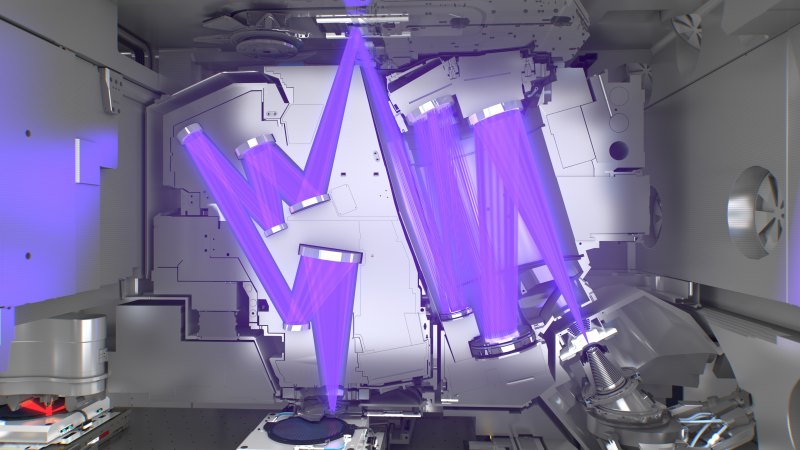
Last week shares in the company critical to the making of the most advanced semiconductors plunged after a disappointing earnings report. Two days later, shares in the world’s biggest chipmaker soared, highlighting the great divide that has opened up in a strategic industry that is critical to 21st century technologies. The company whose shares plummeted more than 20 per cent was the Dutch giant, ASML, which has a near-monopoly on making the machines that produce the most advanced semiconductors.
The one that soared almost 10 per cent was one of ASML’s biggest customers, Taiwan Semiconductor Manufacturing Corp (TSMC), the world’s largest manufacturer of chips. Taiwan Semiconductor Manufacturing Company shares surged after it unveiled a record profit. Credit: Reuters ASML lost more than $97 billion of market capitalisation on Tuesday and Wednesday last week after reporting far weaker than expected orders for its machines.
It reported bookings of €2.6 billion ($4.2 billion) in the September quarter, less than half the €5.
4 billion consensus forecast of analysts. It also lowered its guidance for 2025, saying it expected net sales to be between €30 billion and €35 billion, compared with its previous forecast of up to €40 billion. TSMC, in contrast, had its share price surge after it reported a record profit of 352.
3 billion Taiwanese dollars (about $15 billion) in the September quarter, up 54 per cent from the same quarter last year. It reported continuing strong demand for its chips. Why such a divergence in the fortunes in two of the companies that are critical to the supply chain for semiconductors, the building blocks for technologies ranging from smartphones and cars to artificial intelligence? The answer probably lies in TSMC’s greater exposure to the boom in artificial intelligence (AI).
Among its customer base are companies like Nvidia, the company leading that boom , as well as AMD and Qualcomm. ASML sells its large and ultra-expensive machines that print circuit patterns onto silicon wafers to companies such as TSMC, Samsung and Intel. Samsung recently apologised to its shareholders for its poor financial performance and delays in producing the kinds of high-end chips used in AI.
Intel, also experiencing disappointing financial performance, is slashing its workforce by 15,000 while also failing to keep up with competitors in the AI boom. It was OpenAI’s release of its ChatGPT chatbot nearly two years ago that ignited the excitement around AI and triggered an explosion in spending by companies such as Google, Microsoft, Amazon and Meta Platforms (Facebook’s parent) as they raced to develop AI products perceived to have the potential to transform businesses and economies. ASML sells its large, expensive machines that print circuit patterns onto silicon wafers to companies such as TSMC, Samsung and Intel.
Between them the biggest tech companies invested about $US60 billion ($90 billion) in the September quarter, mostly on AI, and are on track to have spent about $US230 billion by the end of the year, which would be about 50 per cent more than their combined investments last year. That has been a bonanza for companies like Nvidia, at the forefront of developing the most advanced chips needed to build and train AI models, and TSMC, which manufactures the chips. Those companies that have fallen behind the bleeding edge of AI chip development are more exposed to the economic cycle.
During the pandemic there was a massive increase in demand for chips as consumers scrambled to update their home offices to adapt to working from home and spent the fiscal largesse that governments of most of the major developed economies showered on consumers and businesses. The chipmakers significantly increased their production capacity to meet the demand but, when the pandemic-induced boom subsided, were left with substantial excess capacity. Global sales of semiconductors fell more than 8 per cent last year.
While they have bounced back this year – they have been running about 20 per cent higher than last year in recent months – the combination of the capacity overhang of the less advanced chips and missing out on the best of the AI demand has impacted some of the biggest industry players. There’s also a geopolitical dimension, one that might well soon impact even the successful AI players. The US has been steadily cracking down on the supplies of advanced chips to China and has put increasing pressure on its allies to halt the flow of their chips to that country, as well as immense pressure on the Dutch government to stop ASML selling machines capable of manufacturing those chips to China.
Last week there were reports that the Biden administration is considering capping sales of Nvidia and other US companies’ advanced AI chips on a country-by-country basis, tightening the restrictions beyond China, as using a national security screen to determine access to the chips. Restricted access to the chips might also provide leverage to “encourage” other countries to reconsider their relationships with China. Nvidia has been another AI winner.
Credit: Bloomberg The administration is also, according to the technology focused online masthead The Information , investigating whether TSMC has been making AI or advanced smartphone chips for Huawei, the Chinese telecommunications giant that has been banned from acquiring chips manufactured or designed with any input from US companies. In other words, there is a very heavy geopolitical overlay on the industry, which is caught up in the efforts by the US to limit or slow the development of China’s technological capabilities, critical to China’s own ambition of dominating key advanced technologies and industry sectors. For companies like ASML and TSMC and, more recently, Nvidia, that means they are being progressively cut off from one of the biggest markets for their products.
ASML is already foregoing revenue from sales to Chinese customers and income from repairing them as a result of the steadily tightening government restrictions, while TSMC has been building plants in the US and Japan to diversify its geographies beyond Taiwan in response to the heightened tensions between the US and China – and China’s own aggressively-stated intention of reuniting Taiwan with mainland China. There are risks even for those companies leading the AI charge. While the mega-tech companies are all spending massive amounts to develop their AI models and applications, none of them has yet developed the “killer app” that would justify the scale of investment and their investors are just starting to question whether the returns in future will ever justify the investments.
At the moment, they are all charging ahead in the scramble to find those killer apps, which is providing the boom for AI chipmakers and data centre operators and keeping a high floor under their own share prices as well. At some point in the not-too-distant future, however, the huge amounts of capital involved will have to provide commercial returns or they will dry up, while the ever-intensifying geopolitical frictions and the blocs of aligned economies they are producing is also casting a darkening shadow over both chip manufacturers and their customers, whether or not they have an exposure to AI. The Business Briefing newsletter delivers major stories, exclusive coverage and expert opinion.
Sign up to get it every weekday morning ..














